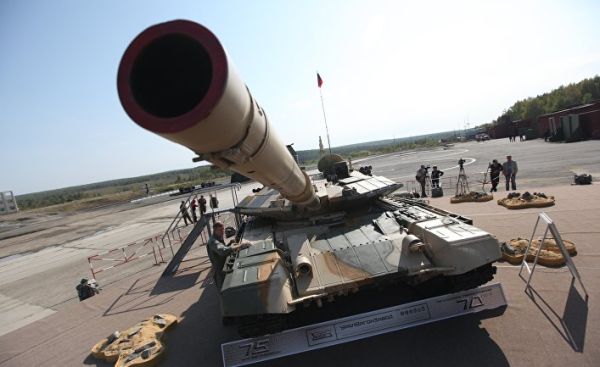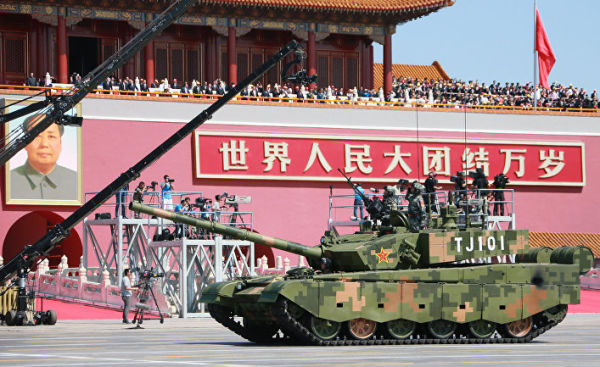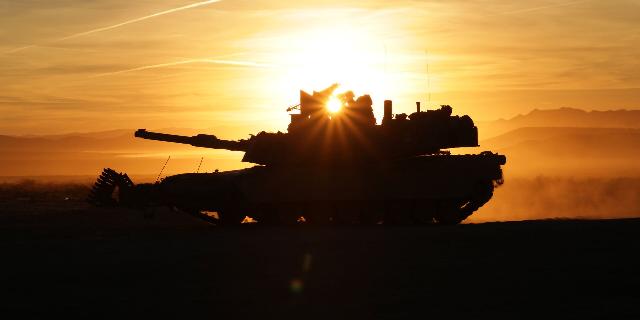China has a lot of tanks. And who else will keep a huge number of combat vehicles in working order? Answer: The USA and Russia. However, most Chinese tanks are old models, but there is also a new Type 99 tank, which has a set of unique properties. What does it look like in comparison with the two most important contemporaries — the American M1A2 Abrams and the Russian T-90.
Sebastien Roblin
The Type 99 tank is much faster than its competitors in terms of speed and is able to accelerate up to 80 kilometers per hour when driving on the road. The M1 Abrams and T-90MS tanks, which India uses, follow him, and their speed indicators are 68 kilometers per hour and 72 kilometers per hour, respectively. However, the voracious power plant of the M1A2 Abrams tank equipped with a turbine allows you to drive 390 kilometers, after which you need to refuel, whereas both the Type 99 and T-90 are able to travel more than 480 kilometers. In addition, the greater weight of the M1 means that it is more difficult to transport and place.
China has a lot of tanks. About eight or nine thousand. And who else would keep such a huge number of combat vehicles in working order? Answer: The United States. And Russia (Note: in such calculations, tanks in storage and in reserve are taken into account. All armies have fewer vehicles in combat units and divisions).
However, most Chinese tanks are old models, especially the Type 59 and Type 69, which were more or less directly copied from the Soviet T-54 tank of the 50s. There are so many of them that I once had the pleasure of running into him on a playground in the city of Tianjin, where he served the needs of the (younger) generation.
However, the new Chinese Type 99 tank has won great respect from international observers, although it has never been exported or used in real combat conditions. The reason is simple - the reported parameters match the characteristics of many Western models, but the Type 99 also has a set of unique properties.
Today we will look at how the Type 99 looks in comparison with its two most important contemporaries - the American M1A2 Abrams and the Russian T-90.
Before we get our hands dirty with technical details, we should ask ourselves the question: Does China even need tanks?
This is a well-founded question. China's main military efforts are directed towards the Pacific Ocean.
Someone may ask: how likely is a collision between an American M1 Abrams tank and a Chinese Type 99?
When answering this question, some factors should be taken into account: can these combat vehicles swim across the Pacific Ocean and exchange shots in the area of Scarborough Shoal Island? Seriously speaking, such a situation seems unlikely, with the exception of an amphibious operation scenario suitable for the computer game Operation Flashpoint.
On the other hand, Taiwan has expressed interest in acquiring Abrams tanks, 60 vehicles of this type are also in service with Australia, and therefore nothing can be excluded.
At the same time, this issue becomes more relevant if we consider the Russian T-90 tank. Moscow currently maintains good relations with Beijing, with which it shares a border, but the two powers are not close allies, and in the late 1960s, war almost broke out between them.
More importantly, Russia sells its weapons to India and Vietnam - including systems that are clearly designed to counter China's armed forces. We are talking about the Brahmos cruise missiles, as well as about ... about one thousand T-90 tanks, many of which are located on the border in the Himalayas.
China launched a war against India in 1962 over this particular border, and it also had a military conflict with Vietnam in 1979, the purpose of which was to punish the Vietnamese for opposing the Chinese-backed Khmer Rouge regime in Cambodia (Vietnam also wants to purchase T-90 tanks).
Today, the Chinese military continues to see India - this country may become a superpower in the future - as a threat, and they have significantly militarily strengthened the area of the joint border, as well as built roads allowing heavy military equipment to overcome mountain passes. China also has allied relations with Pakistan, which has repeatedly fought with India, and sometimes Beijing transfers its military technology to it.
Finally, the scenario of a possible civil war or government collapse in North Korea should be considered. What Beijing's policy will be in this case is a trillion-dollar question, but one of the scenarios provides for the possibility of using Chinese ground forces to restore order in North Korea, which could lead to clashes with Korean troops.
Although a real armed conflict would be unnecessary and extremely counterproductive for all parties involved - like all wars in general - there are some options in which tank battles can occur on the Chinese border, especially against Russian-made tanks.
First you need to introduce your competitors…
The Abrams, of course, is a classic American tank, with which Soviet-made Iraqi armored forces were dealt a crushing defeat in 1991 during the Persian Gulf War. At that time, not a single American tank was lost as a result of enemy fire. Abrams tanks cannot be called new, but the US Army is constantly improving ammunition, armor, as well as various kinds of sensors in order to keep up with the times.
The T-90 is the first Russian tank developed after the end of the Cold War. Although the T-90 is somewhat inferior to the Abrams, its designers have significantly improved shooting accuracy and security - especially in those models that are equipped with dynamic protection. Russia recently unveiled its revolutionary T-14 tank, but today its 550 T-90A tanks continue to be the backbone of its armored forces.
 |
| The T-90AM tank presented at the VIII International Arms Exhibition. |
| Source: RIA Novosti, Sergey Mamontov |
Moscow also developed a more advanced T-90AM tank, but it did not reach mass production. Nevertheless, 354 cars of the export version of this model were sold to India for placement on the border with China. In total, India has 1,200 T-90s, while Algeria would like to eventually have 800 such combat vehicles at its disposal.
The body of the Chinese Type 99 tank closely resembles the elongated T-72, while its turret is made in a Western style and was partially inspired by the German Leopard 2 tank. For the first time, the Type 98 as a prototype appeared on parade during China's main public holiday in 1999, and then it was finalized and entered service in 2001 under the designation Type 99. Its weight is 57 tons, and according to this indicator it is between the 70-ton Abrams and the 48-ton T-90. Several upgrades, including the development of a new Type 99A2 model, have been made using new technologies. Beijing has 500 Type 99 tanks at its disposal in 16 armored battalions, and, in addition, 124 new Type 99A tanks have already been produced. This model is not offered for export, although some technologies are used in the production of the VT4 export variant (VT4).
Firepower
The Type 99 and T-90 tanks are equipped with a 125 mm cannon, and also have a Soviet-designed carousel automatic loader. This gun, as it turned out, is inferior to the Abrams and Challenger guns, which were used during the Persian Gulf War, however, improved tungsten shells make it possible to penetrate the frontal armor of the Abrams from a closer distance.
The new Type 99A2 model has a gun with an elongated barrel, and theoretically this means an increase in the initial flight speed of sub-caliber ammunition, as well as an increase in their accuracy and armor-piercing ability.
According to reports, the Chinese intended to install a 140-millimeter cannon on their Type 99 tank, but it was damaged during testing. As for the Russians, they are going to install a gun of the same caliber on their T-14 tank.
Rheinmetall's 120-millimeter cannon, mounted on Abrams tanks, can use politically controversial M829 depleted uranium shells, whose ability to penetrate armor protection has been increased by 15-25%. Currently, the United States is producing a new version of the M829 projectile, which can overcome the Contact and Relict dynamic protection options developed by Russia (details below).
China has developed its own uranium ammunition for its 125mm cannon, which is claimed to be capable of piercing the M1 Abrams armor from a distance of 1.4 kilometers.
The fourth member of the crew of the Abrams is engaged in loading the cannon, which, according to American tankers, is a more reliable way. In addition, this increases its firepower, and also allows, if necessary, to notice one of the disabled crew member. However, additional space is needed for the fourth crew member, which makes the M1 Abrams tank more massive and heavier.
The Type 99 and T-90 are capable of firing anti-tank missiles through the barrel of their guns, whereas the Abrams does not have such capabilities (the Type 99 tank uses Reflex missiles manufactured under a Russian license). Theoretically, they can be used to fire at targets from a very long distance, as well as against low-flying helicopters. Tank-launched missiles have been around for 50 years, but so far they have not been actively used.
Effective sensors for detecting targets and pointing guns at them are as important in tank combat as firepower. Russia has recently made some progress in the field of tank optics and thermal imagers, but many observers believe that Western vision devices and sensors retain their superiority. The T-90A tank is not equipped with the best Russian systems (some of them are equipped with French-made Catherine thermal imagers, whereas the T-90MS tanks already have an improved Kalina fire control system.
China is known for its excellent electronics, and the Type 99A2 tank is said to be equipped with a new infrared tracking system that allows it to effectively fight enemy tanks, and, according to experts, it surpasses the system that is installed on the T-90A.
Protection
The Type 99 tank has both composite armor and dynamic protection (Explosive Reactive Armor), that is, blocks with explosives are placed on its body, which preemptively detonate incoming projectiles. The new Type 99A2 tank uses a multi-layered system, which is said to be similar to the Russian Relict dynamic protection system, it uses radar to detonate an enemy projectile even before it comes into contact with the tank's armor. They are designed to combat dual-charge missiles capable of overcoming the active protection systems of the previous generation.
The T-90A tank uses the Kontakt-5 active protection system, whereas the new T-90MS models supplied to India are already equipped with the Relict system. Both of these systems have proven effective in the fight against anti-tank missiles, and, in addition, they reduce the penetrating power of tank shells.
An on-board Laser Warning Receiver is also installed on the Type 99 tank, which warns the crew about exposure to an enemy laser guidance system, which allows the driver-mechanic to leave the danger zone. Taking into account all the videos from Syria and Yemen, which show the use of anti-tank missiles (they are often in flight for 20 seconds), this can significantly increase survival.
In addition, a powerful blinding laser of its own design is installed on the Type 99 tank, whose task is to create interference for missiles guided by laser and infrared rays. In addition, their task is to defeat enemy optical devices, blinding enemy gunner operators, perhaps even forever. Fortunately, the powerful blinding lasers installed on tanks have not yet been used in combat conditions, and therefore we cannot say how they work. The new A2 Abrams tank, apparently, also has a laser-based communication system that can be used to identify friendly combat vehicles, as well as to transmit encrypted messages.
 |
| The main battle tank Type 99 A2 of the People's Liberation Army of China. |
| Source: RIA Novosti, Anton Denisov |
On the other hand, the T-90 tank uses an electron-optical (soft kill) active protection system "Curtain", which not only suppresses lasers with its own emitters, but also uses aerosol grenades to create a cloud impervious to the laser beam around the combat vehicle.
The M1 Abrams tank does not have its own laser warning system, there is no active protection system and there is no dynamic protection, however, it can be assumed that in the future new modifications will have some of these characteristics.
So far, the M1A2 Abrams relies on the excellent multilayer composite armor Chobham (Chobham composite armor), which has been improving for many years, and, according to experts, it is comparable to 800-millimeter (or even larger) rolled hardened armor when attacked with sub-caliber projectiles, or with 1300 millimeter armor when using shaped projectiles and missiles with a similar warhead. According to reports, the maximum reservation of the T-90 tank is about 650 millimeters of rolled armor of increased hardness. The advantage of the Abrams tank also consists in the separate storage of ammunition, which reduces the possibility of their catastrophic detonation when hit by an enemy projectile.
The combination of composite and modular armor of the Type 99 tank provides it, according to experts, with protection equivalent to the Abrams tank. According to one source, its protection is equivalent to 1,100 millimeters of high-strength katana armor, although the actual figures continue to remain secret.
Mobility
The Type 99 tank is much faster than its competitors in terms of speed and is able to accelerate up to 80 kilometers per hour when driving on the road. The M1 Abrams and T-90MS tanks, which India uses, follow him, and their speed indicators are 68 kilometers per hour and 72 kilometers per hour, respectively. However, the voracious power plant of the M1A2 tank equipped with a turbine allows it to travel 390 kilometers, after which it is necessary to refuel, whereas both the Type 99 and T-90 are capable of traveling more than 480 kilometers. In addition, the greater weight of the M1 Abrams means that it is more difficult to transport and place it.
In conclusion, it should be noted that the Type 99 has a digital service system comparable to that with which the latest modifications of the M1 Abrams tank are beginning to be equipped.
In general, we can say that the Abrams have the highest combat power of these three tanks, whereas the Type 99 probably has the best protection due to the presence of a multi-level system. In addition, it is faster and has a longer range.
As a rule, the T-90 tank is inferior to its competitors, but the T-90MS, equipped with a Relict protection system, an improved optical sight and a more powerful engine, is quite capable of competing with them.
However, it should be borne in mind that the true booking capabilities of the Type 99 tank, its cannon and electronic systems remain uncertain - in particular, due to the fact that it is not exported, whereas both M1 Abrams and T-90 are used in many armies of the world.
Beijing does not like to disclose details about its technologies, and, moreover, it often exaggerates the capabilities of its equipment. Nevertheless, the available data suggest that China, despite the huge number of Type 59 tanks, is able to develop and adopt first-class main battle tanks. This fits well into President Xi Jinping's recently announced plans to reduce the number and improve the quality of his armed forces.


